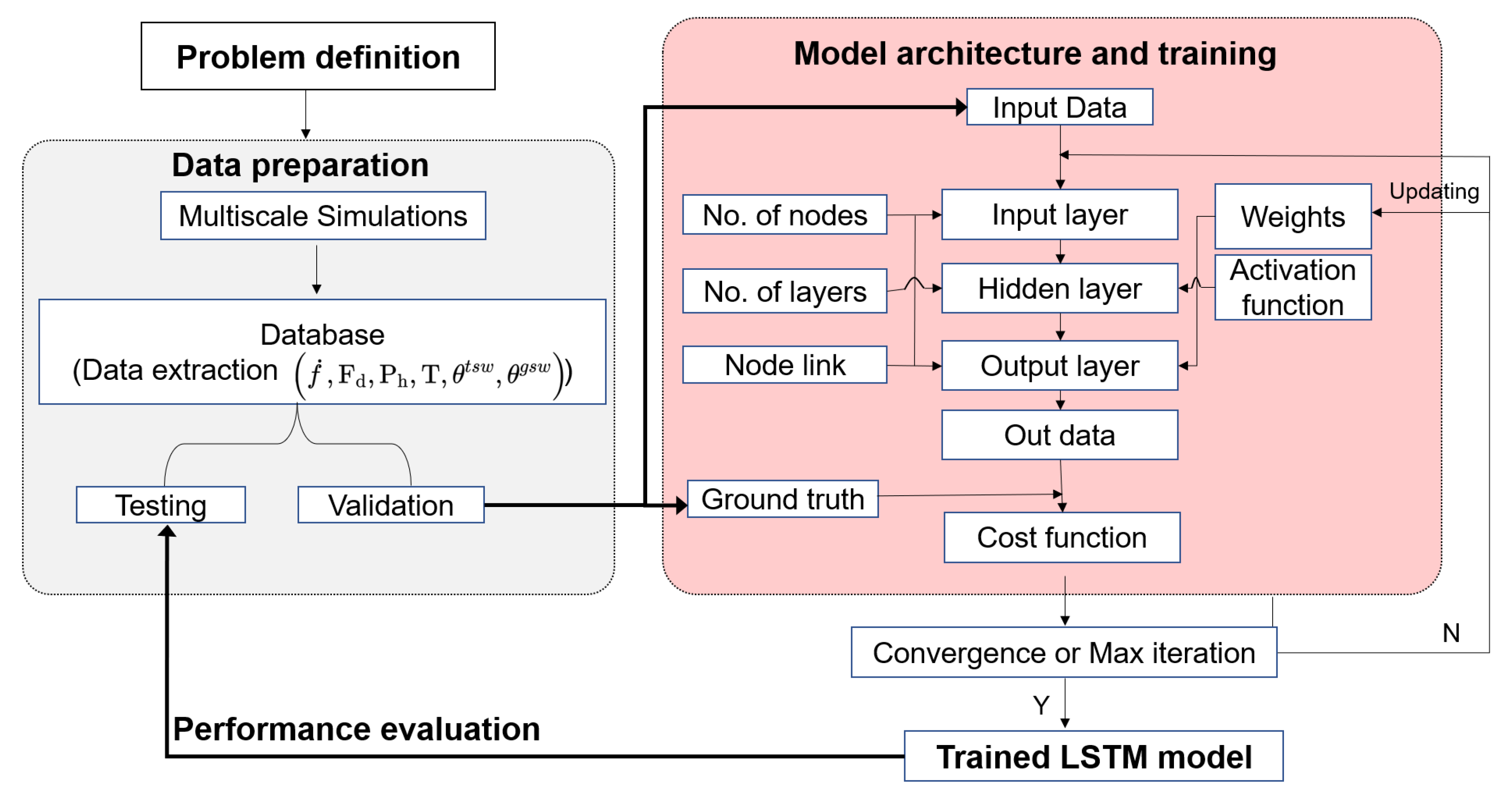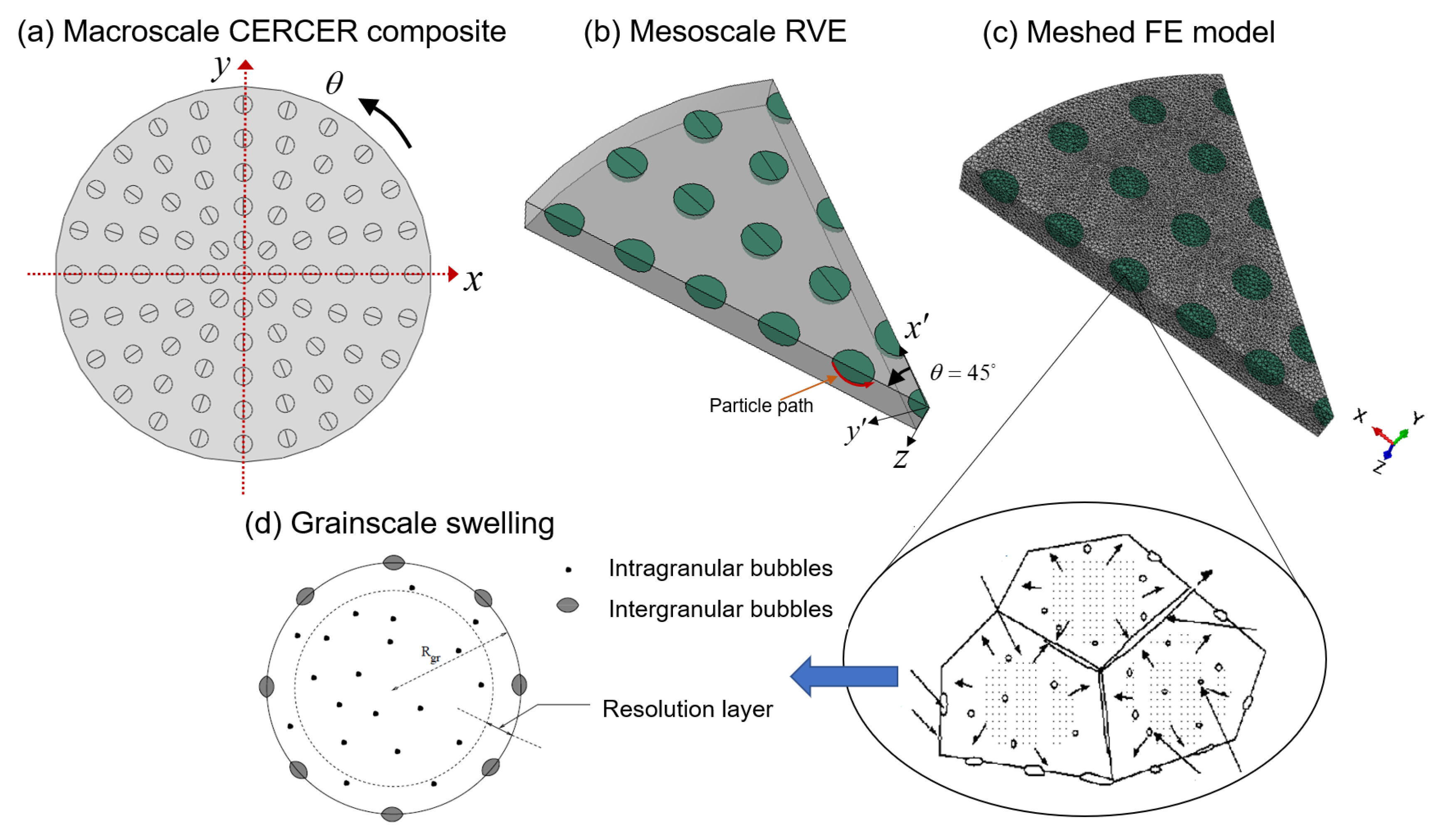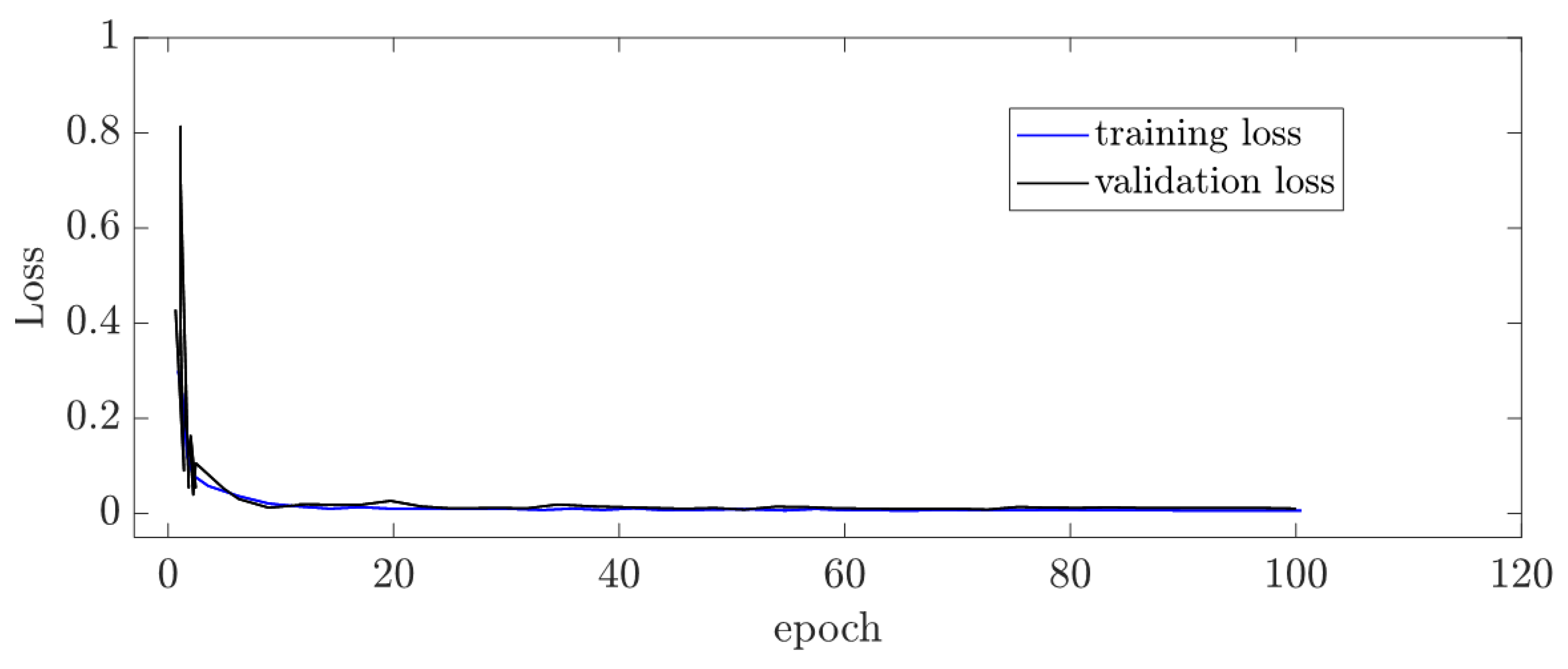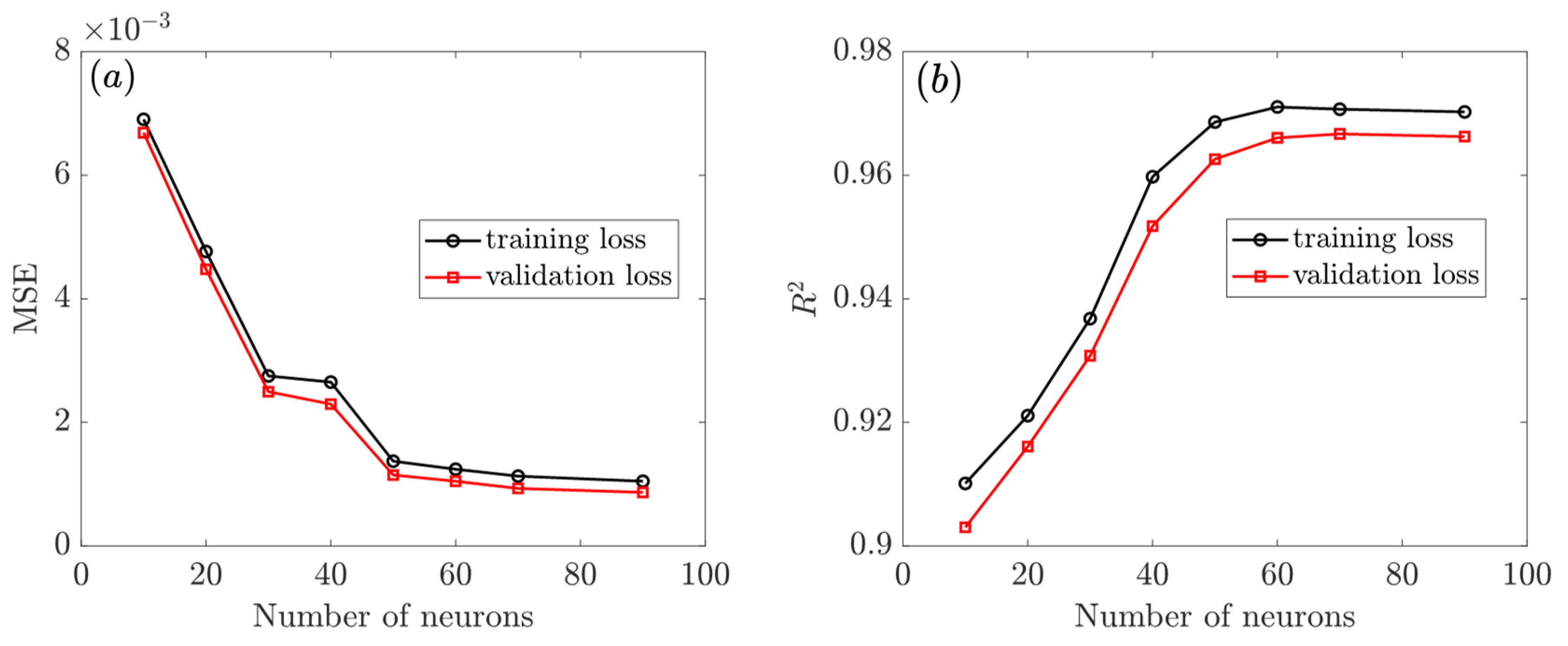Application of LSTM Approach for Predicting the Fission Swelling Behavior within a CERCER Composite Fuel
Abstract
1. Introduction
2. Method
2.1. Integration Mode of Multiscale Modeling and Machine Learning
2.2. Knowledge-Based Multiscale Modeling
2.3. Data-Driven LSTM Deep Learning Scheme
2.4. Model Training and Evaluation
3. Results and Discussion
3.1. Evaluation of the Data-Driven Model
3.2. Predictions from the Data-Driven Model
3.3. Interpretation of the Data-Driven Model Using Feature Selection Analysis
4. Conclusions
- (1)
- Results predicted by the data-driven method exhibit a high and in the training dataset and 0.95 in the validation dataset. The trained LSTM model performs excellently and accurately in predicting the hydrostatic-pressure-temperature dependent swelling behavior of CERCER composite fuels.
- (2)
- The LSTM model has comparatively greater performance at solid swelling prediction; it also distinguishes between solid shared swelling and labeled total swelling and catches the moment at which recrystallization first appears for gas swelling.
- (3)
- The interpretation analysis gives quantitative information about how the data-driven model interprets the loading and physical characteristics and how they relate to various swelling contributions. The variables such as temperature T and hydrostatic pressure are dominant features in predicting gas swelling portions.
Author Contributions
Funding
Data Availability Statement
Conflicts of Interest
References
- Aitkaliyeva, A.; He, L.; Wen, H.; Miller, B.; Bai, X.M.; Allen, T. Irradiation effects in Generation IV nuclear reactor materials. In Structural Materials for Generation IV Nuclear Reactors; Elsevier: Amsterdam, The Netherlands, 2017; pp. 253–283. [Google Scholar]
- Chen, D.; He, X.; Chu, G.; He, X.; Jia, L.; Wang, Z.; Yang, W.; Hu, C. An overview: Multiscale simulation in understanding the radiation damage accumulation of reactor materials. Simulation 2021, 97, 659–675. [Google Scholar] [CrossRef]
- Kohnert, A.A.; Wirth, B.D.; Capolungo, L. Modeling microstructural evolution in irradiated materials with cluster dynamics methods: A review. Comput. Mater. Sci. 2018, 149, 442–459. [Google Scholar] [CrossRef]
- Robinson, A.; Williams, W.; Hanson, W.; Rabin, B.; Lybeck, N.; Meyer, M. Swelling of U-Mo monolithic fuel: Developing a predictive swelling correlation under research reactor conditions. J. Nucl. Mater. 2021, 544, 152703. [Google Scholar] [CrossRef]
- Rest, J.; Cooper, M.; Spino, J.; Turnbull, J.; Van Uffelen, P.; Walker, C. Fission gas release from UO2 nuclear fuel: A review. J. Nucl. Mater. 2019, 513, 310–345. [Google Scholar] [CrossRef]
- Kim, D.U.; Blondel, S.; Bernholdt, D.E.; Roth, P.; Kong, F.; Andersson, D.; Tonks, M.R.; Wirth, B.D. Modeling mesoscale fission gas behavior in UO2 by directly coupling the phase field method to spatially resolved cluster dynamics. Mater. Theory 2022, 6, 1–28. [Google Scholar] [CrossRef]
- Rest, J. A model for the effect of the progression of irradiation-induced recrystallization from initiation to completion on swelling of UO2 and U–10Mo nuclear fuels. J. Nucl. Mater. 2005, 346, 226–232. [Google Scholar] [CrossRef]
- Li, Y.; Hu, S.; Sun, X.; Stan, M. A review: Applications of the phase field method in predicting microstructure and property evolution of irradiated nuclear materials. Npj Comput. Mater. 2017, 3, 1–17. [Google Scholar] [CrossRef]
- Cui, Y.; Ding, S.; Huo, Y.; Wang, C.; Yang, L. An efficient numerical method for intergranular fission gas evolution under transient with piecewise boundary resolution. J. Nucl. Mater. 2013, 443, 570–578. [Google Scholar] [CrossRef]
- Tonks, M.; Andersson, D.; Devanathan, R.; Dubourg, R.; El-Azab, A.; Freyss, M.; Iglesias, F.; Kulacsy, K.; Pastore, G.; Phillpot, S.R.; et al. Unit mechanisms of fission gas release: Current understanding and future needs. J. Nucl. Mater. 2018, 504, 300–317. [Google Scholar] [CrossRef]
- Zhao, Y.; Ding, S.; Zhang, X.; Wang, C.; Yang, L. Effects of fuel particle size and fission-fragment-enhanced irradiation creep on the in-pile behavior in CERCER composite pellets. J. Nucl. Mater. 2016, 482, 278–293. [Google Scholar] [CrossRef]
- Zhao, Y.; Gong, X.; Ding, S. Simulation of the irradiation-induced thermo-mechanical behaviors evolution in monolithic U–Mo/Zr fuel plates under a heterogeneous irradiation condition. Nucl. Eng. Des. 2015, 285, 84–97. [Google Scholar] [CrossRef]
- Chen, X.N.; Rineiski, A.; Maschek, W.; Liu, P.; Boccaccini, C.M.; Sobolev, V.; Delage, F.; Rimpault, G. Comparative studies of CERCER and CERMET fuels for EFIT from the viewpoint of core performance and safety. Prog. Nucl. Energy 2011, 53, 855–861. [Google Scholar] [CrossRef]
- Miao, Y.; Gamble, K.A.; Andersson, D.; Ye, B.; Mei, Z.G.; Hofman, G.; Yacout, A.M. Gaseous swelling of U3Si2 during steady-state LWR operation: A rate theory investigation. Nucl. Eng. Des. 2017, 322, 336–344. [Google Scholar] [CrossRef]
- Booth, A. A Method of Calculating Gas Diffusion from UO2 Fuel and Its Application to the X-2-f Loop Test; AECL Chalk River Report, CRDC-721; 1957. Available online: https://www.osti.gov/servlets/purl/4331839 (accessed on 7 November 2022).
- Gurtin, M.E. An Introduction to Continuum Mechanics; Academic Press: Cambridge, MA, USA, 1982. [Google Scholar]
- Polyanin, A.D. Functional separable solutions of nonlinear reaction–diffusion equations with variable coefficients. Appl. Math. Comput. 2019, 347, 282–292. [Google Scholar] [CrossRef]
- Zhao, Y.; Zhang, J.; Ding, S. A new method for solving the fission gas diffusion equations with time-varying diffusion coefficient and source term considering recrystallization of fuel grains. Nucl. Mater. Energy 2019, 20, 100686. [Google Scholar] [CrossRef]
- Xiang, F.; He, Y.; Niu, Y.; Deng, C.; Wu, Y.; Wang, K.; Tian, W.; Su, G.; Qiu, S. A new method to simulate dispersion plate-type fuel assembly in a multi-physics coupled way. Ann. Nucl. Energy 2022, 166, 108734. [Google Scholar] [CrossRef]
- Yang, G.; Liao, H.; Ding, T.; Chen, H. Preliminary study on the thermal-mechanical performance of the U3Si2/Al dispersion fuel plate under normal conditions. Nucl. Eng. Technol. 2021, 53, 3723–3740. [Google Scholar] [CrossRef]
- Ye, L.; Wang, M.; Wang, X.; Deng, J.; Xiang, Y.; Tian, W.; Qiu, S.; Su, G. Thermal hydraulic and neutronics coupling analysis for plate type fuel in nuclear reactor core. Sci. Technol. Nucl. Install. 2020, 2020, 2562747. [Google Scholar] [CrossRef]
- Liu, X.Y.; Andersson, D. Molecular dynamics study of fission gas bubble nucleation in UO2. J. Nucl. Mater. 2015, 462, 8–14. [Google Scholar] [CrossRef]
- Hu, S.; Joshi, V.; Lavender, C.A. A rate-theory–phase-field model of irradiation-induced recrystallization in UMo nuclear fuels. Jom 2017, 69, 2554–2562. [Google Scholar] [CrossRef]
- Zhao, Y.; Ding, S.; Huo, Y.; Wang, C.; Yang, L. Irradiation-induced thermomechanical behavior in ads composite fuel pellets: Mechanism and main influencing factors. J. Therm. Stress. 2016, 39, 630–657. [Google Scholar] [CrossRef]
- Ding, S.; Zhao, Y.; Wan, J.; Gong, X.; Wang, C.; Yang, L.; Huo, Y. Simulation of the irradiation-induced micro-thermo-mechanical behaviors evolution in ADS nuclear fuel pellets. J. Nucl. Mater. 2013, 442, 90–99. [Google Scholar] [CrossRef]
- Guo, K.; Yang, Z.; Yu, C.H.; Buehler, M.J. Artificial intelligence and machine learning in design of mechanical materials. Mater. Horizons 2021, 8, 1153–1172. [Google Scholar] [CrossRef]
- Zohdi, T. Dynamic thermomechanical modeling and simulation of the design of rapid free-form 3D printing processes with evolutionary machine learning. Comput. Methods Appl. Mech. Eng. 2018, 331, 343–362. [Google Scholar] [CrossRef]
- Alber, M.; Buganza Tepole, A.; Cannon, W.R.; De, S.; Dura-Bernal, S.; Garikipati, K.; Karniadakis, G.; Lytton, W.W.; Perdikaris, P.; Petzold, L.; et al. Integrating machine learning and multiscale modeling—perspectives, challenges, and opportunities in the biological, biomedical, and behavioral sciences. NPJ Digit. Med. 2019, 2, 1–11. [Google Scholar] [CrossRef]
- Zhang, J.; Wang, H.; Wei, H.; Zhang, J.; Tang, C.; Lu, C.; Huang, C.; Ding, S.; Li, Y. Modelling of effective irradiation swelling for inert matrix fuels. Nucl. Eng. Technol. 2021, 53, 2616–2628. [Google Scholar] [CrossRef]
- Morgan, D.; Pilania, G.; Couet, A.; Uberuaga, B.P.; Sun, C.; Li, J. Machine learning in nuclear materials research. Curr. Opin. Solid State Mater. Sci. 2022, 26, 100975. [Google Scholar] [CrossRef]
- Rossa, R.; Borella, A.; Giani, N. Comparison of machine learning models for the detection of partial defects in spent nuclear fuel. Ann. Nucl. Energy 2020, 147, 107680. [Google Scholar] [CrossRef]
- Kobayashi, K.; Okumura, M.; Nakamura, H.; Itakura, M.; Machida, M.; Cooper, M.W. Machine learning molecular dynamics simulations toward exploration of high-temperature properties of nuclear fuel materials: Case study of thorium dioxide. Sci. Rep. 2022, 12, 1–11. [Google Scholar] [CrossRef]
- Mishra, V.; Branger, E.; Elter, Z.; Grape, S.; Jansson, P. Comparison of supervised machine learning algorithms to predict PWR spent fuel parameters. In Proceedings of the INMM & ESARDA Joint Annual Meeting 2021, Vienna, Austria, 21–26 August 2021. [Google Scholar]
- Cai, L.; Xu, F.; Di Lemma, F.G.; Giglio, J.J.; Benson, M.T.; Murray, D.J.; Adkins, C.A.; Kane, J.J.; Xian, M.; Capriotti, L.; et al. Understanding fission gas bubble distribution, lanthanide transportation, and thermal conductivity degradation in neutron-irradiated α-U using machine learning. Mater. Charact. 2022, 184, 111657. [Google Scholar] [CrossRef]
- Wu, L.; Kilingar, N.G.; Noels, L. A recurrent neural network-accelerated multi-scale model for elasto-plastic heterogeneous materials subjected to random cyclic and non-proportional loading paths. Comput. Methods Appl. Mech. Eng. 2020, 369, 113234. [Google Scholar] [CrossRef]
- Yu, Y.; Si, X.; Hu, C.; Zhang, J. A review of recurrent neural networks: LSTM cells and network architectures. Neural Comput. 2019, 31, 1235–1270. [Google Scholar] [CrossRef] [PubMed]
- Dong, Y.; Tao, J.; Zhang, Y.; Lin, W.; Ai, J. Deep learning in aircraft design, dynamics, and control: Review and prospects. IEEE Trans. Aerosp. Electron. Syst. 2021, 57, 2346–2368. [Google Scholar] [CrossRef]
- Parish, E.J.; Carlberg, K.T. Time-series machine-learning error models for approximate solutions to parameterized dynamical systems. Comput. Methods Appl. Mech. Eng. 2020, 365, 112990. [Google Scholar] [CrossRef]
- Zhao, Y.; Zhao, H.; Ai, J.; Dong, Y. Robust Data-Driven Fault Detection: An Application to Aircraft Air Data Sensors. Int. J. Aerosp. Eng. 2022, 2022, 2918458. [Google Scholar] [CrossRef]
- Chen, G. Recurrent neural networks (RNNs) learn the constitutive law of viscoelasticity. Comput. Mech. 2021, 67, 1009–1019. [Google Scholar] [CrossRef]
- Im, S.; Lee, J.; Cho, M. Surrogate modeling of elasto-plastic problems via long short-term memory neural networks and proper orthogonal decomposition. Comput. Methods Appl. Mech. Eng. 2021, 385, 114030. [Google Scholar] [CrossRef]
- Qu, T.; Di, S.; T Feng, Y.; Wang, M.; Zhao, T.; Wang, M. Deep Learning Predicts Stress–Strain Relations of Granular Materials Based on Triaxial Testing Data. Comput. Model. Eng. Sci. 2021, 128. [Google Scholar] [CrossRef]
- Gong, X.; Zhao, Y.; Ding, S. A new method to simulate the micro-thermo-mechanical behaviors evolution in dispersion nuclear fuel elements. Mech. Mater. 2014, 77, 14–27. [Google Scholar] [CrossRef]
- Zhao, Y.; Gong, X.; Cui, Y.; Ding, S. Simulation of the fission-induced swelling and creep in the CERCER fuel pellets. Mater. Des. 2016, 89, 183–195. [Google Scholar] [CrossRef]
- Schielzeth, H. Simple means to improve the interpretability of regression coefficients. Methods Ecol. Evol. 2010, 1, 103–113. [Google Scholar] [CrossRef]
- Nagelkerke, N.J. A note on a general definition of the coefficient of determination. Biometrika 1991, 78, 691–692. [Google Scholar] [CrossRef]
- Gulli, A.; Pal, S. Deep Learning with Keras; Packt Publishing Ltd.: Birmingham, UK, 2017. [Google Scholar]
- Neeft, E.; Bakker, K.; Schram, R.; Conrad, R.; Konings, R. The EFTTRA-T3 irradiation experiment on inert matrix fuels. J. Nucl. Mater. 2003, 320, 106–116. [Google Scholar] [CrossRef]
- Dayhoff, J.E.; DeLeo, J.M. Artificial neural networks: Opening the black box. Cancer Interdiscip. Int. J. Am. Cancer Soc. 2001, 91, 1615–1635. [Google Scholar] [CrossRef]
- Cai, J.; Luo, J.; Wang, S.; Yang, S. Feature selection in machine learning: A new perspective. Neurocomputing 2018, 300, 70–79. [Google Scholar] [CrossRef]









| [, ,, T] | [, , ] | [, , T] | ||
|---|---|---|---|---|
| 0.95 | 0.91 | 0.93 | ||
| Before recrystallization | 0.94 | 0.90 | 0.92 | |
| 0.98 | 0.99 | 0.99 | ||
| 0.93 | 0.88 | 0.92 | ||
| After recrystallization | 0.91 | 0.85 | 0. 88 | |
| 0.98 | 0.98 | 0.98 |
Publisher’s Note: MDPI stays neutral with regard to jurisdictional claims in published maps and institutional affiliations. |
© 2022 by the authors. Licensee MDPI, Basel, Switzerland. This article is an open access article distributed under the terms and conditions of the Creative Commons Attribution (CC BY) license (https://creativecommons.org/licenses/by/4.0/).
Share and Cite
Zhao, J.; Chen, Z.; Tu, J.; Zhao, Y.; Dong, Y. Application of LSTM Approach for Predicting the Fission Swelling Behavior within a CERCER Composite Fuel. Energies 2022, 15, 9053. https://doi.org/10.3390/en15239053
Zhao J, Chen Z, Tu J, Zhao Y, Dong Y. Application of LSTM Approach for Predicting the Fission Swelling Behavior within a CERCER Composite Fuel. Energies. 2022; 15(23):9053. https://doi.org/10.3390/en15239053
Chicago/Turabian StyleZhao, Jian, Zhenyue Chen, Jingqi Tu, Yunmei Zhao, and Yiqun Dong. 2022. "Application of LSTM Approach for Predicting the Fission Swelling Behavior within a CERCER Composite Fuel" Energies 15, no. 23: 9053. https://doi.org/10.3390/en15239053
APA StyleZhao, J., Chen, Z., Tu, J., Zhao, Y., & Dong, Y. (2022). Application of LSTM Approach for Predicting the Fission Swelling Behavior within a CERCER Composite Fuel. Energies, 15(23), 9053. https://doi.org/10.3390/en15239053







